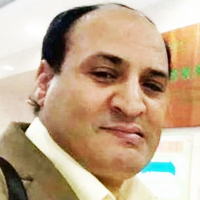Abstract
Research Article
The Risk Factors for Ankle Sprain in Cadets at a Male Military School in Iran: A Retrospective Case-control Study
Farzad Najafipour*, Farshad Najafipour, Mohammad Hassan Majlesi and Milad Darejeh
Published: 23 March, 2017 | Volume 1 - Issue 1 | Pages: 020-026
Introduction: Ankle sprain is a widespread impairment in sport groups; this impairment leads to an absence from the workplace. The ankle sprains incidence rates are induced by height, weight, BMI, physical fitness, level of match, classification of sport, and personal exposure to sport.
Methods: A longitudinal case-control study was executed to verify the outcome of risk factors for ankle sprain at a Military Male School between 2012 and 2013 of 4987 people at risk for ankle sprain, a total of 234 cadets sustained new ankle sprains during the study, 432 non-injured cadets randomly selected as the control group.
Results: Regarding to the total people at risk in our study the incidence rate was approximately 5/1000 ankle sprain-years. Cadets with ankle sprains had higher weight, BMI and higher scores in Army Physical Fitness test than the control group. Ankle sprain occurred most commonly during athletics (51.4%). Ankle sprain incidence rate did not significantly vary from different athletic competitions after controlling for athlete-exposure. Soccer and Ball Games had the highest ankle sprain incidence rate.
Conclusion: Higher weight, increased BMI, greater physical conditioning and athlete exposure to selected sports were all risk factors for ankle sprain.
Read Full Article HTML DOI: 10.29328/journal.jcmei.1001005 Cite this Article Read Full Article PDF
Keywords:
Ankle injuries; Military personnel; Risk factor
References
- O'Connor SR, Bleakley CM, Tully MA, McDonough SM. Predicting functional recovery after acute ankle sprain. PLoS One. 2013; 8. Ref.: https://goo.gl/T8XL0p
- González de Vega C, Speed C, Wolfarth B, González J. Traumeel vs. diclofenac for reducing pain and improving ankle mobility after acute ankle sprain: a multicentre, randomised, blinded, controlled and non-inferiority trial. Int J Clin Pract. 2013; 67: 979-989. Ref.: https://goo.gl/Voq6PM
- Wähnert D, Grüneweller N, Evers J, Sellmeier AC, Raschke MJ, et al. An unusual cause of ankle pain: fracture of a talocalcaneal coalition as a differential diagnosis in an acute ankle sprain: a case report and literature review. BMC Musculoskelet Disord. 2013; 14: 111. Ref.: https://goo.gl/DevRcJ
- Park J, Hahn S, Park JY, Park HJ, Lee H. Acupuncture for ankle sprain: systematic review and meta-analysis. BMC Complement Altern Med. 2013; 13: 55. Ref.: https://goo.gl/bdEQIK
- Baumbach SF, Fasser M, Polzer H, Sieb M, Regauer M, et al. Study protocol: the effect of whole body vibration on acute unilateral unstable lateral ankle sprain-a biphasic randomized controlled trial. BMC Musculoskelet Disord. 2013; 14: 22. Ref.: https://goo.gl/QwmuzM
- Cosby NL, Koroch M, Grindstaff TL, Parente W, Hertel J. Immediate effects of anterior to posterior talocrural joint mobilizations following acute lateral ankle sprain. J Man Manip Ther. 2011; 19: 76-83. Ref.: https://goo.gl/yMGdgF
- Bergmann G, Ciritsis BD, Wanner GA, Simmen HP, Werner CM, et al. Gastrocnemius muscle herniation as a rare differential diagnosis of ankle sprain: case report and review of the literature. Patient Saf Surg. 2012; 6: 5. Ref.: https://goo.gl/bgxCGV
- Witjes S, Gresnigt F, van den Bekerom MP, Olsman JG, van Dijk NC. The ANKLE TRIAL (ankle treatment after injuries of the ankle ligaments): what is the benefit of external support devices in the functional treatment of acute ankle sprain? A randomised controlled trial. BMC Musculoskelet Disord. 2012; 13: 21. Ref.: https://goo.gl/PQJkZa
- Cohen M, Parker S, Taylor D, Smit de V, Ben-Meir M, et al. Acupuncture as analgesia for low back pain, ankle sprain and migraine in emergency departments: study protocol for a randomized controlled trial. Trials. 2011; 12: 241. Ref.: https://goo.gl/F920vN
- Dubin JC, Comeau D, McClelland RI, Dubin RA, Ferrel E. Lateral and syndesmotic ankle sprain injuries: a narrative literature review. J Chiropr Med. 2011; 10: 204-219. Ref.: https://goo.gl/qC1nzh
- Sinnott BA, Strote J. Severe open ankle sprain. West J Emerg Med. 2011; 12: 581-582. Ref.: https://goo.gl/Rs5UBt
- Mohamed M, Wong CK. More than meets the eye: clinical reflection and evidence-based practice in an unusual case of adolescent chronic ankle sprain. Phys Ther. 2011; 91: 1395-1402. Ref.: https://goo.gl/HsGpLX
- Klykken LW, Pietrosimone BG, Kim KM, Ingersoll CD, Hertel J. Motor-neuron pool excitability of the lower leg muscles after acute lateral ankle sprain. J Athl Train. 2011; 46: 263-269. Ref.: https://goo.gl/SoOZ9K
- Lionberger DR, Joussellin E, Lanzarotti A, Yanchick J, Magelli M. Diclofenac epolamine topical patch relieves pain associated with ankle sprain. J Pain Res. 2011; 4: 47-53. Ref.: https://goo.gl/Z84of1
- Lionberger DR, Joussellin E, Yanchick J, Magelli M, Lanzarotti A. Pooled analysis of clinical trial data evaluating the safety and effectiveness of diclofenac epolamine topical patch 1.3% for the treatment of acute ankle sprain. Open Access J Sports Med. 2011; 2: 75-84. Ref.: https://goo.gl/WoHaat
- Van Rijn RM, Willemsen SP, Verhagen AP, Koes BW, Bierma-Zeinstra SM. Explanatory variables for adult patient’s self-reported recovery after acute lateral ankle sprain. Phys Ther. 2011; 91: 77-84. Ref.: https://goo.gl/yF21hT
- Steffen K, Nilstad A. Ankle exercises in combination with intermittent ice and compression following an ankle sprain improves function in the short term. J Physiother. 2010; 56: 202. Ref.: https://goo.gl/4WePSa
- Sandoval MC, Ramirez C, Camargo DM, Salvini TF. Effect of high-voltage pulsed current plus conventional treatment on acute ankle sprain. Rev Bras Fisioter. 2010; 14: 193-199. Ref.: https://goo.gl/LH3Osf
- Bleakley CM, O'Connor SR, Tully MA, Rocke LG, Macauley DC, et al. Effect of accelerated rehabilitation on function after ankle sprain: randomised controlled trial. BMJ. 2010; 340: c1964. Ref.: https://goo.gl/opsXyo
- Hubbard TJ, Wikstrom EA. Ankle sprain: Pathophysiology, Predisposing factors, and Management strategies. Open Access J Sports Med. 2010; 1: 115-122. Ref.: https://goo.gl/XMXbnl
- Struijs PA, Kerkhoffs GM. Ankle sprain. Clin Evid (Online). 2010; 1115. Ref.: https://goo.gl/zChOyH
- Fong DT, Chan YY, Mok KM, Yung PSh, Chan KM. Understanding acute ankle ligamentous sprain injury in sports. Sports Med Arthrosc Rehabil Ther Technol. 2009; 1: 14. Ref.: https://goo.gl/8ZFIh1
- Hupperets MD, Verhagen EA, Van Mechelen W. Effect of unsupervised home based proprioceptive training on recurrences of ankle sprain: randomised controlled trial. BMJ. 2009; 339: b2684. Ref.: https://goo.gl/kME0FB
- Cooke MW, Marsh JL, Clark M, Nakash R, Jarvis RM, et al. Treatment of severe ankle sprain: a pragmatic randomized controlled trial comparing the clinical effectiveness and cost-effectiveness of three types of mechanical ankle support with tubular bandage. The CAST trial. Health Technol Assess. 2009; 13: 1-121. Ref.: https://goo.gl/Qc8mVd
Similar Articles
-
The Risk Factors for Ankle Sprain in Cadets at a Male Military School in Iran: A Retrospective Case-control StudyFarzad Najafipour*,Farshad Najafipour,Mohammad Hassan Majlesi,Milad Darejeh. The Risk Factors for Ankle Sprain in Cadets at a Male Military School in Iran: A Retrospective Case-control Study. . 2017 doi: 10.29328/journal.jcmei.1001005; 1: 020-026
Recently Viewed
-
Pulmonary Infarction Mimicking An Aspergilloma In A Heart Transplant RecipientAntonacci F*,Belliato M,Bortolotto C,Di Perna D,Dore R,Orlandoni G,D’Armini AM. Pulmonary Infarction Mimicking An Aspergilloma In A Heart Transplant Recipient . J Clin Med Exp Images. 2017: doi: 10.29328/journal.jcmei.1001002; 1: 005-006
-
Recurrent Peripheral Ameloblastoma of the Mandible: A Case ReportAngela Jordão Camargo*,Mayara Cheade,Celso Martinelli,Plauto Christopher Aranha Watanabe. Recurrent Peripheral Ameloblastoma of the Mandible: A Case Report. J Clin Med Exp Images. 2017: doi: 10.29328/journal.jcmei.1001003; 1: 007-010
-
The Risk Factors for Ankle Sprain in Cadets at a Male Military School in Iran: A Retrospective Case-control StudyFarzad Najafipour*,Farshad Najafipour,Mohammad Hassan Majlesi,Milad Darejeh. The Risk Factors for Ankle Sprain in Cadets at a Male Military School in Iran: A Retrospective Case-control Study. J Clin Med Exp Images. 2017: doi: 10.29328/journal.jcmei.1001005; 1: 020-026
-
Magnetic Resonance Imaging Can Detect Symptomatic Patients with Facet Joint Pain. A Retrospective AnalysisWolfgang Freund*,Frank Weber,Reinhard Meier,Stephan Klessinger. Magnetic Resonance Imaging Can Detect Symptomatic Patients with Facet Joint Pain. A Retrospective Analysis. J Clin Med Exp Images. 2017: doi: 10.29328/journal.jcmei.1001006; 1: 027-036
-
Secondary Onychomycosis Development after Cosmetic Procedure-Case ReportMariusz Dyląg*,Emilia Flisowska,Patryk Bielecki,Maria Kozioł-Gałczyńska,Weronika Jasińska. Secondary Onychomycosis Development after Cosmetic Procedure-Case Report . J Clin Med Exp Images. 2017: doi: 10.29328/journal.jcmei.1001007; 1: 037-045
Most Viewed
-
Impact of Latex Sensitization on Asthma and Rhinitis Progression: A Study at Abidjan-Cocody University Hospital - Côte d’Ivoire (Progression of Asthma and Rhinitis related to Latex Sensitization)Dasse Sery Romuald*, KL Siransy, N Koffi, RO Yeboah, EK Nguessan, HA Adou, VP Goran-Kouacou, AU Assi, JY Seri, S Moussa, D Oura, CL Memel, H Koya, E Atoukoula. Impact of Latex Sensitization on Asthma and Rhinitis Progression: A Study at Abidjan-Cocody University Hospital - Côte d’Ivoire (Progression of Asthma and Rhinitis related to Latex Sensitization). Arch Asthma Allergy Immunol. 2024 doi: 10.29328/journal.aaai.1001035; 8: 007-012
-
Causal Link between Human Blood Metabolites and Asthma: An Investigation Using Mendelian RandomizationYong-Qing Zhu, Xiao-Yan Meng, Jing-Hua Yang*. Causal Link between Human Blood Metabolites and Asthma: An Investigation Using Mendelian Randomization. Arch Asthma Allergy Immunol. 2023 doi: 10.29328/journal.aaai.1001032; 7: 012-022
-
An algorithm to safely manage oral food challenge in an office-based setting for children with multiple food allergiesNathalie Cottel,Aïcha Dieme,Véronique Orcel,Yannick Chantran,Mélisande Bourgoin-Heck,Jocelyne Just. An algorithm to safely manage oral food challenge in an office-based setting for children with multiple food allergies. Arch Asthma Allergy Immunol. 2021 doi: 10.29328/journal.aaai.1001027; 5: 030-037
-
Snow white: an allergic girl?Oreste Vittore Brenna*. Snow white: an allergic girl?. Arch Asthma Allergy Immunol. 2022 doi: 10.29328/journal.aaai.1001029; 6: 001-002
-
Cytokine intoxication as a model of cell apoptosis and predict of schizophrenia - like affective disordersElena Viktorovna Drozdova*. Cytokine intoxication as a model of cell apoptosis and predict of schizophrenia - like affective disorders. Arch Asthma Allergy Immunol. 2021 doi: 10.29328/journal.aaai.1001028; 5: 038-040

If you are already a member of our network and need to keep track of any developments regarding a question you have already submitted, click "take me to my Query."

















































































































































